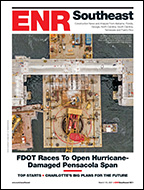The Mississippi River flood fight is keeping inspectors on the job around the clock, even as the bulge of highest water slides south. Contractors are fighting boils and seepage. Approximately 25 miles north of Vicksburg, Miss., crews performed emergency repairs on some 400 linear ft of mainline levee that sustained two slides on the land-side.

Observers first spotted the slides on May 16, according to the U.S. Army Corps of Engineers. A Corps spokesperson says more such damage can be expected in the coming weeks as super-saturated levees strain to contain historic flooding.
“The levee system is under tremendous pressure from the highest water stages that we have ever seen,” says Henry A. Dulaney, chief of the Corps’ engineering & construction division in Vicksburg.
The two, adjacent slide areas were classified as shallow—only 3 to 4 ft deep. Since they occurred on the land-side face of the levee embankment, they were not considered failures of the levee itself, says Chuck Mendrop, chief of the geotechnical branch, Vicksburg District, USACE. “Slides can occur due to weak foundations beneath the levee or as a result of seepage pressures,” Mendrop says. “Seepage pressures occur during high water stages as water seeps through and under the levee,” which was the case with these shallow slides.
In contrast, deep-seated slides create major stability problems when the foundation yields and part of the embankment rotates down along a fault plane. Repairs depend on the size of the slide and location of the failure plane. “Methods include constructing stability berms, deep soil mixing to strengthen the foundation soils, use of geosynthetics, and other techniques,” Mendrop says.
Round-the-clock work began to repair the shallow slides was completed by May 24 with Lampkin Construction, Vicksburg, hauling in 7,000 tons of rock and 11,000 tons of sand. Corps employees used the rock to create a dike at the bottom of the levee, which was then backfilled with sand. The combination provides weight and stability for the levee while allowing water to seep out.
“We could have additional slides on the levee as the water level falls out, mainly on the river side of the levee,” Mendrop says. “We have these type slides every year. They are shallow slides and we normally repair them by digging out the slide material, treating it with lime [to strengthen the soil] and rebuilding the river-side slope.”
Despite sand boils and slides throughout the Mississippi Rivers & Tributaries Project area, the system is performing as designed, says Mendrop. “This is the largest flood event the levees have ever experienced, and overall the levees are performing well.”
Dulaney says the Corps has taken a number of safety precautions. Throughout Mississippi and Louisiana, the angency has halted construction, as well as vehicular and pedestrian traffic, on or near earthen levees that have been saturated for weeks. It also is conducting round-the-clock inspections, augmented by montiroing by local levee boards, law enforcement officers and various state agencies.


Post a comment to this article
Report Abusive Comment